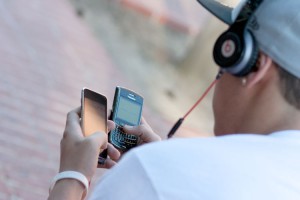Mobile usage creates higher demand for bandwidth
The USC student body reflects a national trend of college students using mobile devices daily to access the Internet, and this has compelled Information Technology Services to improve its wireless coverage, according to Kevin Durkin, director of communication and marketing for Information Technology Services.

Technology · Phil Jones, a sophomore majoring in communications, uses his phone and iPod to access the Internet. Information Technology Services says wireless availability is a top concern on both USC campuses. - Alex Dealy | Daily Trojan
The Educause Center for Applied Research, which provides research and analysis to universities to help them make better decisions on technology, recently released a report that found that during the last two years, the percentage of college students who use their phones to obtain daily access to the Internet has grown significantly.
Durkin said the increased use of mobile devices to access the USC wireless network has led to an increase in bandwidth demand on the network.
“It’s also due to the fact that students now use devices that take up much more bandwidth,” Durkin said. “Mobile devices that are used to download music, or upload pictures or videos to social networking sites take up a lot of bandwidth.”
Bandwidth is the amount of data that can be transferred in a given period of time. The larger the number of people who are accessing the Internet to download items or play movies, the slower the bandwidth.
The large amount of smart phone technology and the increased demand for bandwidth led ITS to launch its wireless network upgrade initiative last August to increase the speed, capacity and area covered by the USC network.
“The goal of the initiative is to provide pervasive wireless coverage in the University Park and Health Sciences campuses,” Durkin said.
The high amount of network traffic has left some students with complaints about USC’s wireless network.
“I definitely think that the USC network needs to improve. I don’t even get good signal in my apartment,” said Denise Rick, an undeclared sophomore.
Each year, when ITS conducts its annual customer service survey, wireless availability is always a top concern, Durkin said.
The initial phase to upgrade its wireless network, which will be completed in the next several weeks, includes upgrading wireless connectivity in all academic buildings on both campuses to have the greatest impact on students
“The first phase of the project is almost 90 percent completed,” Durkin said. “The next phase will involve upgrading the surrounding areas of both campuses as well as 77 off-campus buildings.”
ITS’ next goal is to upgrade wireless connectivity in administrative buildings on campus. So far, 3,100 new access points have been installed on campus and are equipped with the technology that gives the wireless network the ability to handle a greater number of users.
All phases of the project will be completed in time for fall of 2011, according to Durkin.
Durkin said that since implementing the new wireless network, ITS has noticed that the bandwidth usage at the university almost tripled, which he attributed to the greater number of access points, the stronger signal strength and the greater coverage area of the network.
“The new, expanded wireless network infrastructure has been built to accommodate and sustain the growth in bandwidth usage by all members of the USC community, including students,” Durkin said.
Yili Shi, a junior majoring in business administration, said she has noticed the changes to the wireless network around campus.
“Last semester, there was a classroom in Hoffman Hall where I was never able to get a signal, but this semester I can access the network from the same classroom,” Shi said.
Not all students, however, are experiencing the benefits of the new USC wireless network.
“My AT&T 3G network is much faster than USC wireless, so for consistency I use my 3G network,” said Lily Muntzing, a sophomore majoring in communication. “It’s only in certain areas, like the basement of Annenberg, that I switch over to USC Wi-Fi because I can’t get signal on my phone’s network.”
Students who wish to check the status of a building’s wireless network upgrade can visit www.usc.edu/its.

We’re pretty far behind most public schools, so about time… I’ve noticed better coverage around University Village, but I’ve also noticed that connectivity in Kaprielian Hall is as bad as ever.